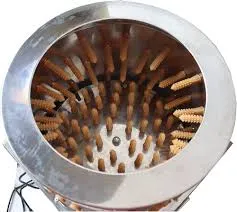Feed Mixer Equipment for Efficient Animal Feed Production and Blending Solutions
Nov . 29, 2024 12:53 Back to list
Feed Mixer Equipment for Efficient Animal Feed Production and Blending Solutions
Understanding Feed Mill Mixer Machines A Critical Component in Animal Nutrition
In the constantly evolving world of animal husbandry, the efficiency and effectiveness of feed production play a pivotal role in ensuring the health and productivity of livestock. One of the most essential pieces of equipment in this process is the feed mill mixer machine. These machines are designed to blend various feed ingredients uniformly, providing a balanced diet essential for the optimal growth and health of animals.
The Importance of Feed Mixing
Feed milling is not simply about grinding raw materials; it involves a meticulous process of combining different ingredients to create a nutritious and palatable feed. The uniformity of the mix directly affects the nutritional value of the feed, which in turn impacts animal performance, health, and overall productivity. A well-mixed feed ensures that each animal receives the right amounts of vitamins, minerals, and other nutrients, reducing waste and enhancing feed efficiency.
Types of Feed Mill Mixer Machines
There are several types of feed mill mixer machines, each designed for specific needs and capacities
. The most common types include1. Horizontal Mixers These machines feature a horizontal mixing chamber where feed ingredients are combined using paddles or ribbons. Their large capacity and efficient mixing action make them suitable for medium to large-scale operations.
2. Vertical Mixers With a vertical orientation, these mixers utilize a single or dual screw design to blend ingredients thoroughly. They are often favored in smaller operations due to their compact size and efficient mixing capabilities.
3. Batch Mixers Batch mixers allow for precise control and flexibility in ingredient formulation, making them ideal for producing specialized feeds tailored to specific requirements.
4. Continuous Mixers These machines enable a steady flow of materials, providing a consistent mixture without downtime. Continuous mixers are efficient for large-scale feed operations that require a regular supply of mixed feed.
feed mill mixer machine

Features and Benefits
Modern feed mill mixer machines boast several features that enhance their efficiency and ease of use. These include
- Automated Control Systems Many mixers are equipped with advanced control panels that allow operators to set precise mixing times and speeds, ensuring optimal results every time.
- Safety Features Safety is paramount in any industrial operation. Feed mill mixers are often designed with protective covers and emergency shut-off switches to prevent accidents.
- Durability and Maintenance High-quality materials and construction provide durability, while easy access to components simplifies maintenance and reduces downtime.
Impact on Animal Health and Production
The significance of feed mill mixer machines cannot be overstated. Properly mixed feed reduces the risk of nutritional deficiencies in livestock, promoting better overall health and leading to improved weight gain, milk production, and reproductive performance. Additionally, well-formulated feed can help in reducing feed costs and enhancing the economic viability of animal production.
Conclusion
In conclusion, feed mill mixer machines are a cornerstone of modern animal nutrition. By ensuring that feed is mixed uniformly and efficiently, these machines contribute significantly to the well-being of livestock and the profitability of animal husbandry operations. As the industry continues to innovate, the role of feed mill mixers will likely expand, further enhancing the capabilities of producers in delivering high-quality nutrition to their animals. Investing in the right mixer can lead to substantial benefits, making it an essential consideration for anyone involved in feed production.
-
Hot Sale 24 & 18 Door Rabbit Cages - Premium Breeding Solutions
NewsJul.25,2025
-
Automatic Feeding Line System Pan Feeder Nipple Drinker - Anping County Yize Metal Products Co., Ltd.
NewsJul.21,2025
-
Automatic Feeding Line System Pan Feeder Nipple Drinker - Anping County Yize Metal Products Co., Ltd.
NewsJul.21,2025
-
Automatic Feeding Line System - Anping Yize | Precision & Nipple
NewsJul.21,2025
-
Automatic Feeding Line System - Anping Yize | Precision & Nipple
NewsJul.21,2025
-
Automatic Feeding Line System-Anping County Yize Metal Products Co., Ltd.|Efficient Feed Distribution&Customized Animal Farming Solutions
NewsJul.21,2025






